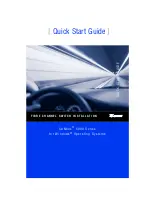
Electrical powering
The powering of the product must adhere to the power specifications indicated on the marking labels.
The power supply must be Class II and a Limited Power Source in accordance with the requirements of IEC60950/ EN60950, Clause 2.5 and rated as
indicated on the label on the bottom side of your product. It must be tested and approved to national or local standards.
For US and Canada
: This product is intended to be supplied by a Listed Direct Plug-in, or Desktop Power Unit marked "Class 2" and rated as
indicated on the label on the bottom side of your product.
The use of other types of supplies is prohibited. If you are not sure of the type of power supply needed, consult the product's user documentation
or contact your local product dealer.
USB
The device is to be connected to an identified USB port complying with the requirements of a Limited Power Source.
Telephone cable
CAUTION
: To reduce the risk of fire, use only No 26 AWG wire size or larger telecommunication line cord.
Follow the installation instructions in the sequence as outlined in the installation guide.
Accessibility
The Direct Plug-in power supply, or the plug on the power supply cord serves as disconnect device. Be sure that the power socket outlet you plug
the power supply into is easily accessible and located as close to the equipment as possible.
Overloading
Do not overload mains supply socket outlets and extension cords as this increases the risk of fire or electric shock.
Servicing
To reduce the risk of electric shock, do not disassemble this product. None of its internal parts are user-replaceable; therefore, there is no reason to
access the interior. Opening or removing covers may expose you to dangerous voltages. Incorrect reassembly could cause electric shock if the
appliance is subsequently used.
If service or repair work is required, take it to a qualified service dealer.
Damage requiring service
Unplug this product from the wall outlet and refer servicing to qualified service personnel under the following conditions:
•
When the power supply or its plug are damaged.
•
When the attached cords are damaged or frayed.
•
If liquid has been spilled into the product.
•
If the product has been exposed to rain or water.
•
If the product does not operate normally.
•
If the product has been dropped or damaged in any way.
•
There are noticeable signs of overheating.
•
If the product exhibits a distinct change in performance.
Immediately disconnect the product if you notice it giving off a smell of burning or smoke. Under no circumstances must you open the equipment
yourself; you run the risk of electrocution.
Regulatory Information
You must install and use this device in strict accordance with the manufacturer's instructions as described in the user documentation that is
included with your product.
Before you start installation or use of this product, carefully read the contents of this document for device specific constraints or rules that may
apply in the country where you want to use this product.
THOMSON is not responsible for any radio or television interference caused by unauthorized modification of the device, or the substitution or
attachment of connecting cables and equipment other than specified by THOMSON. The correction of interference caused by such unauthorized
modification, substitution or attachment will be the responsibility of the user.
THOMSON and its authorized resellers or distributors are not liable for any damage or violation of government regulations that may arise from
failing to comply with these guidelines.
North-America - United States of America
Federal Communications Commission (FCC) Radio Frequency Interference Statement
If not installed and used in accordance with the instructions, it may cause harmful interference to radio communications. However, there is no
guarantee that interference will not occur in a particular installation. If this equipment does cause harmful interference to radio or television
reception, which can be determined by turning the equipment ON and OFF, the user is encouraged to try to correct the interference by one or
more of the following measures:
•
Reorient or relocate the receiving antenna.
•
Increase the separation between the equipment and receiver.
•
Connect the equipment into an outlet on a circuit different from that to which the receiver is connected.
•
Consult the dealer or an experienced radio/television technician for help.
The FCC requires the user to be notified that any changes or modifications to this device that are not expressly approved by THOMSON may void
the user's authority to operate the equipment.
Responsible Party: THOMSON Inc., 10330 North Meridian Street, Indianapolis, IN 46290 USA, (580) 634-0151.
This equipment complies with Part 68 of the FCC Rules.
This device has been tested and found to comply with the limits for a Class B digital device, pursuant to Part 15 of the FCC Rules. These
limits are designed to provide reasonable protection against such interference in a residential installation.
This equipment generates, uses and can radiate radio frequency energy. Operation is subject to the following two conditions:
1
This device may not cause harmful interference, and
2
This device must accept any interference received, including interference that may cause undesired behaviour.
This equipment complies with FCC RF radiation exposure limits set forth for an uncontrolled environment. This equipment should be installed and
operated with a minimum distance of 20 centimeters between the radiator and your body. This transmitter must not be co-located or operated in
conjunction with any other antenna or transmitter.”
























